 |
| Gutenberg Printing room at the Museum Photo CPM |
 | |
| Click on image to go to bigger size to print Photo CPM |
Why am I interested in helping this museum here is some of mine and its history.
 |
| Front of Crandall Historical Printing Museum photo CPM |
Well that dream I had other people have had such as Louis Crandall but he lives his dream which might be turning into a nightmare.
 |
| click on image for better view Photo CPM |
15 years ago he had a dream to open up a 501(c)3 non-profit museum all about movable print and where it came from and where it has gone in history. Located at 275 East Center Street in Provo , Utah 84606 in a very small little building that can easily be missed when driving past in this building his dreams came to life. This modest little building houses some amazing items in printmaking history. Movable type has changed the way the human race has looked at the world and interacted with it.
 |
| Johannas Gutenberg Photo CPM |
 |
| Gutenberg Printing Press Photo CPM |
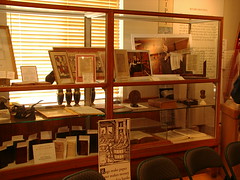 You start out the tour in a room that is decorated as a room would have been in Gutenberg's day and age. You are looking at a massive printing press with most of its parts made out of wood an amazing thing to me as the ones I always worked on in collage yep all metal. You learn how Gutenberg wanted to make movable type but how he had to do it in secrecy because people did not view new things in the "dark ages" as a good thing but something of the devil and witchcraft like. He had to create the type from scratch he had to learn how to make the type and that was no small feat as it had not been done before. He also needed to figure out which metals would work well from unhardened steel to form his letters on, then to temper it and make it hard so that it could then be pushed into copper and make a mold then how to use this mold with a lead
You start out the tour in a room that is decorated as a room would have been in Gutenberg's day and age. You are looking at a massive printing press with most of its parts made out of wood an amazing thing to me as the ones I always worked on in collage yep all metal. You learn how Gutenberg wanted to make movable type but how he had to do it in secrecy because people did not view new things in the "dark ages" as a good thing but something of the devil and witchcraft like. He had to create the type from scratch he had to learn how to make the type and that was no small feat as it had not been done before. He also needed to figure out which metals would work well from unhardened steel to form his letters on, then to temper it and make it hard so that it could then be pushed into copper and make a mold then how to use this mold with a lead 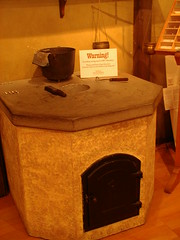 mixture to make the actual type. To do this he needed to make a gadget that would hold the mold and form it from unhardened steel too. All these things were to be done by hand. Mind you while this is being explained to you the person explaining it is also making a letter in type for you I do not mean printing with one but casting a letter and showing the steps to get to the cast point.The explanation of how the type is set into phrases before it is placed into the frame on the press bed. The thing I forgot to say about the type is that the original type had to look like handwriting becasue the people of Gutenberg's time of course were use to handwritten books and it needed to look like that or it would be rejected. Try to write all your letters the same then carve them by hand out of steel and make them all fit size wise with the letters next to them, no small obstacle as Latin which is what this type was in
mixture to make the actual type. To do this he needed to make a gadget that would hold the mold and form it from unhardened steel too. All these things were to be done by hand. Mind you while this is being explained to you the person explaining it is also making a letter in type for you I do not mean printing with one but casting a letter and showing the steps to get to the cast point.The explanation of how the type is set into phrases before it is placed into the frame on the press bed. The thing I forgot to say about the type is that the original type had to look like handwriting becasue the people of Gutenberg's time of course were use to handwritten books and it needed to look like that or it would be rejected. Try to write all your letters the same then carve them by hand out of steel and make them all fit size wise with the letters next to them, no small obstacle as Latin which is what this type was in 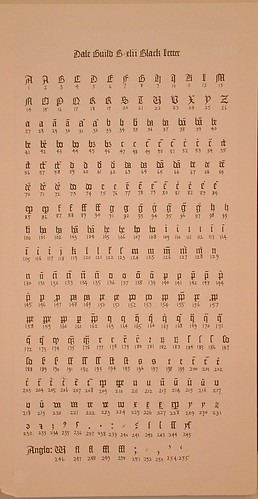 had over 250 letters that needed to be made becasue of the markings that went with the letters. Then we go into the discussion of how the ink was made and that no one has made an ink that was so beautiful and rich and black since ( because we don't use lead and such). Small note he had to create the ink too as it had to be sticky and thick and ink used for writing was thin and watery and would not work with type.
had over 250 letters that needed to be made becasue of the markings that went with the letters. Then we go into the discussion of how the ink was made and that no one has made an ink that was so beautiful and rich and black since ( because we don't use lead and such). Small note he had to create the ink too as it had to be sticky and thick and ink used for writing was thin and watery and would not work with type.  |
| Inking the type Photo CPM |
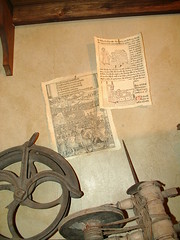 Part of Gutenberg's bible had to be printed on vellum but latter in his printing he did use paper. Which he had to account for the issues with hand made paper it had to be damp to work well for printing. Any one who has gotten paper wet knows how paper drys warped and wavy another thing he had to figure out. Now on to the press oh some one else figured that out for pressing fruit to make juice (wine and the like) but it had to be modified for printing. Yes another thing had to figured out. I would care to say that printing as we know it today is an amazing thing that we take for granted. There is more that happens and is discussed in this first room of the 2 hour tour. Oh and the person demonstrating this does it in less than 15 mins. Amazing since it took Gutenberg 20 years to figure all this stuff out.
Part of Gutenberg's bible had to be printed on vellum but latter in his printing he did use paper. Which he had to account for the issues with hand made paper it had to be damp to work well for printing. Any one who has gotten paper wet knows how paper drys warped and wavy another thing he had to figure out. Now on to the press oh some one else figured that out for pressing fruit to make juice (wine and the like) but it had to be modified for printing. Yes another thing had to figured out. I would care to say that printing as we know it today is an amazing thing that we take for granted. There is more that happens and is discussed in this first room of the 2 hour tour. Oh and the person demonstrating this does it in less than 15 mins. Amazing since it took Gutenberg 20 years to figure all this stuff out.  |
| Original page from a Gutenberg Bible Photo CPM |
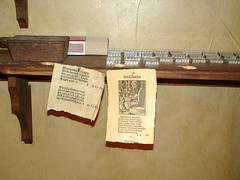 Moveable type brought words to the masses and education to the poor. More is discussed and learned in this room. From ancient illuminated pages that you get to look at up close and personal in
Moveable type brought words to the masses and education to the poor. More is discussed and learned in this room. From ancient illuminated pages that you get to look at up close and personal in 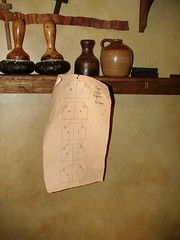 your hands to reproductions of the Gutenberg bible volumes 1 and 2. There was hands on experience for the children and adults as the group pulled two pages from the Gutenberg bible (typeset in Latin). It is interesting to note that before finishing his dream Gutenberg actually lost his shop to his debtors and someone else had to finish his work. Louis Crandall has not yet fulfilled his dream and he too may be loosing his shop to his debtors. Please step in and be the one to help finish this dream and keep a very special one of a kind museum going.
your hands to reproductions of the Gutenberg bible volumes 1 and 2. There was hands on experience for the children and adults as the group pulled two pages from the Gutenberg bible (typeset in Latin). It is interesting to note that before finishing his dream Gutenberg actually lost his shop to his debtors and someone else had to finish his work. Louis Crandall has not yet fulfilled his dream and he too may be loosing his shop to his debtors. Please step in and be the one to help finish this dream and keep a very special one of a kind museum going.
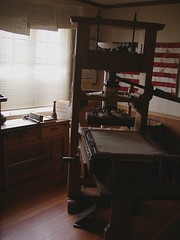
 |
| Benjamin Franklin Photo CPM |
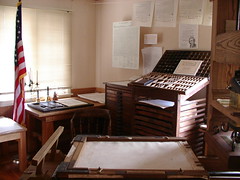 Most of the things we actually note him for doing came after he had retired from printing. It is a wonder the things a person can do while in retirement. The importance of the press and movable type is discussed about how the American revolution began with lead type in the form of printed words like Common Sense and the Declaration of Independence. Lead bullets came after the lead type in the battle for freedom. There is more that is said and shown in this room but I want people to still learn things when they go and just get a taste of what happens there.
Most of the things we actually note him for doing came after he had retired from printing. It is a wonder the things a person can do while in retirement. The importance of the press and movable type is discussed about how the American revolution began with lead type in the form of printed words like Common Sense and the Declaration of Independence. Lead bullets came after the lead type in the battle for freedom. There is more that is said and shown in this room but I want people to still learn things when they go and just get a taste of what happens there. |
| The Declaration of Independence set in type using type made from the molds that the orignal publication in the newspaper used. Photo CPM |
 |
| E.B. Grandin Photo CPM |
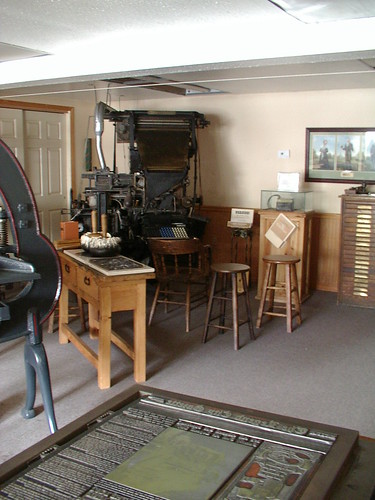
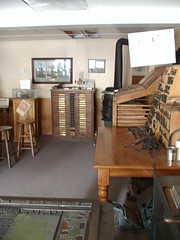 The next room on the tour takes us to another leap in time and faith to 1829 Palmyra NY and the printing of the book of Mormon in the E.B Grandin room. The room in which we stand now is almost the exact size of the room that the Book of Mormon was printed in except for 2 feet short in length to give an idea of the small spaces things had been done in ( 35 ft x 17ft). The growth of the Latter Day Saints (most people call the Mormons) is solely due to the use of the printing press. In this time a large run of a book was about 500 copies and that was considered a very large run but the book of Mormon was a 5000 copy run. The printer was given a farm to make sure the debt to pay for the books would be secured. Just the binding by hand of so large a run would usually take over 2 years to complete. So another amazing feat in the human spirit that sees a larger goal that will encompass many years of ones life to achieve.
The next room on the tour takes us to another leap in time and faith to 1829 Palmyra NY and the printing of the book of Mormon in the E.B Grandin room. The room in which we stand now is almost the exact size of the room that the Book of Mormon was printed in except for 2 feet short in length to give an idea of the small spaces things had been done in ( 35 ft x 17ft). The growth of the Latter Day Saints (most people call the Mormons) is solely due to the use of the printing press. In this time a large run of a book was about 500 copies and that was considered a very large run but the book of Mormon was a 5000 copy run. The printer was given a farm to make sure the debt to pay for the books would be secured. Just the binding by hand of so large a run would usually take over 2 years to complete. So another amazing feat in the human spirit that sees a larger goal that will encompass many years of ones life to achieve.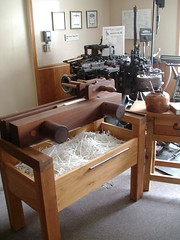 The press we are all looking at now is an Acorn press. It is known by this name becasue the shape of the press is acorn like. It is all cast iron and weights close to a ton. There are other machines in the room we are told to ignore as they are of a different era that we will get to later. A 1930's line o type machine that still works and a mono-type machine from a little later than that. So much knowledge and history in such a small area of space.
The press we are all looking at now is an Acorn press. It is known by this name becasue the shape of the press is acorn like. It is all cast iron and weights close to a ton. There are other machines in the room we are told to ignore as they are of a different era that we will get to later. A 1930's line o type machine that still works and a mono-type machine from a little later than that. So much knowledge and history in such a small area of space.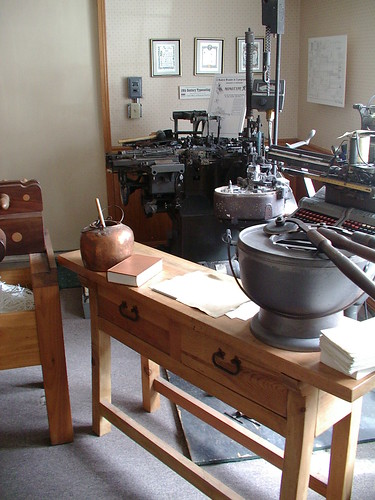 Back to the acorn press set in type on the presses bed is the first 16 pages of the book of Mormon to show how it was done. Sitting in a metal tray next this press is a stack of lead type all mixed up. Yes when they originally set this up there was an accident and page 13 was dumped (no jokes on the number please) and they the museum people decided to leave it that way so that patrons could see how hard it would be to sort type that has been dumped. Through out the exhibit things are hands on and you are aloud to touch the types and also are told that please wash your hands as type is made out of lead and is poisonous. To think the people that discovered printing and used it help our nation be born and to carry out the word of God had all been poisoning themselves (unknown to them of course) to help others. Very humbling indeed!
Back to the acorn press set in type on the presses bed is the first 16 pages of the book of Mormon to show how it was done. Sitting in a metal tray next this press is a stack of lead type all mixed up. Yes when they originally set this up there was an accident and page 13 was dumped (no jokes on the number please) and they the museum people decided to leave it that way so that patrons could see how hard it would be to sort type that has been dumped. Through out the exhibit things are hands on and you are aloud to touch the types and also are told that please wash your hands as type is made out of lead and is poisonous. To think the people that discovered printing and used it help our nation be born and to carry out the word of God had all been poisoning themselves (unknown to them of course) to help others. Very humbling indeed! We are shown how the pages are printed to make the signatures of a book, and one is folded in front of us. The we are shown a book press on the other side of the room and is purpose in making the pages lay flat. Oh and becasue of enhancements in paper making papers no longer have to dry but are printed on dry paper making printing even faster. We are shown how a book block is planed and how it is glued up and formed into a final book.
We are shown how the pages are printed to make the signatures of a book, and one is folded in front of us. The we are shown a book press on the other side of the room and is purpose in making the pages lay flat. Oh and becasue of enhancements in paper making papers no longer have to dry but are printed on dry paper making printing even faster. We are shown how a book block is planed and how it is glued up and formed into a final book.
 Next leap is to 1850 Salt lake city to the printing of the Deseret News newspaper. It is now 400 years after Gutenberg and although much has changed in the world printing is still done letter by letter and still inked up in similar manner (roller brayers over balls but similar concept and idea). There is an example of the first page that came off of that press. Dated June 15 1850. There is a similar item up at This is the Place Monument but I have seen both and this one has a far greater impact on the visitor becasue of all the information that has led up top this point.
Next leap is to 1850 Salt lake city to the printing of the Deseret News newspaper. It is now 400 years after Gutenberg and although much has changed in the world printing is still done letter by letter and still inked up in similar manner (roller brayers over balls but similar concept and idea). There is an example of the first page that came off of that press. Dated June 15 1850. There is a similar item up at This is the Place Monument but I have seen both and this one has a far greater impact on the visitor becasue of all the information that has led up top this point.Next leap 2011 the internet has concurred the world and people carry around digital books the text and touch and feel of a book are fading away from us. As a bookbinder and printer that is a hard thing for me to grasp I so love reading a book and gaining knowledge from it most hings I do I have done becasue of books and being able to sit and teach myself. I love books old and new there is something about them that draws me to them. The economy is languishing and many museums are closing their doors and not for the weekend but permanently to never come back. There is a legacy to be had in our history and what got us here as a world the printing press has changed the face of this earth. It has helped create nations and it has set people free spiritually progress has moved forward becasue of type. Please help this museum stay to give a great legacy in our children yet to be born.
If you have been there and know the value of this museum and what it stands for or if you feel touch by my notes here call, stop by, donate anything to help and do it fast or they will close their doors and you may never be able to see the wonders of this museum. It is truly a one of a kind place.
If you are interested in looking at their web site go to Crandallmuseum.org (they have a donation link in place on there but are having technical difficulties with it and paypal). If you choose to donate to them you can mail them money ( if you do make it rush so they get it in time to save the museum)or call and use a credit card or stop by and give it in person and enjoy the museum too. They are working today to get the credit card/paypal thing fixed on their web site but have been told it may take a few weeks to get that all fixed.
Here is their contact information once again
Crandall Printing Museum
275 East Center St.
Provo, Utah 84606
http://crandallmuseum.org/
phone (801) 377-7777
Gifts to the museum may be made in all forms check/cash/credit card
Small donations are welcome as they all add up to something great in the end. The museum is a 501(c)3 tax exempt public charity Federal Identification number 84-1422774 (you get a tax write off)
Several photos in this post are not my own but are cutesy of Crandall Printing Museum CPM

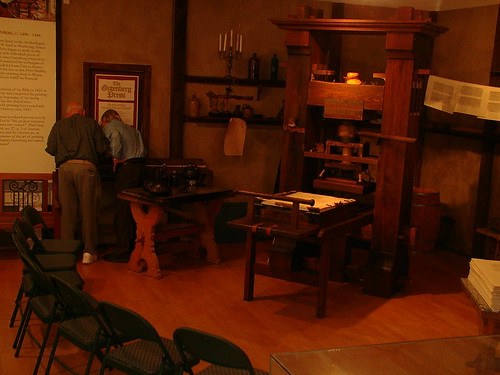
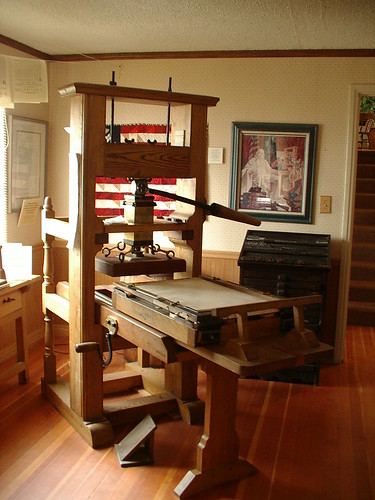
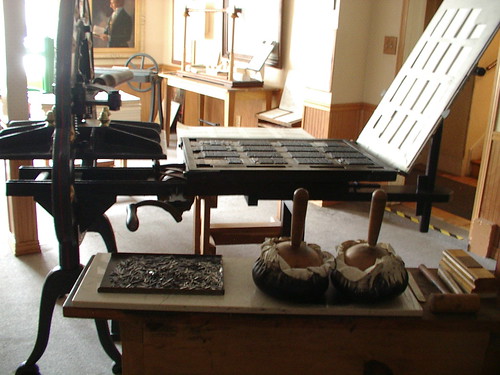

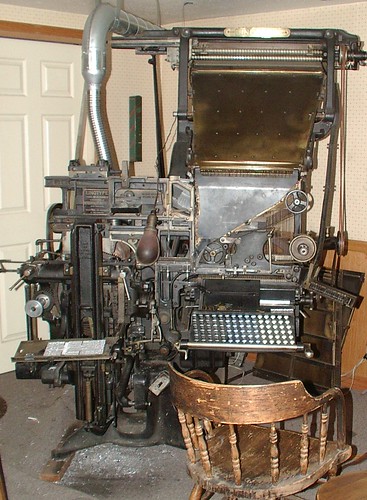
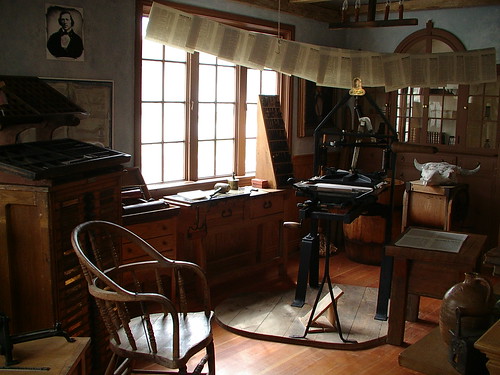
No comments:
Post a Comment